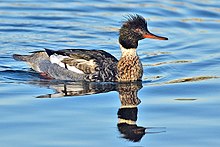Loading AI tools
Genus of birds From Wikipedia, the free encyclopedia
Mergus is the genus of the typical mergansers (/mɜːrˈɡænsərz/ mur-GAN-sərz)[2] fish-eating ducks in the subfamily Anatinae. The genus name is a Latin word used by Pliny the Elder and other Roman authors to refer to an unspecified waterbird.[3][4]
| Typical mergansers | |
|---|---|
 | |
| Red-breasted merganser (Mergus serrator) | |
| Scientific classification | |
| Domain: | Eukaryota |
| Kingdom: | Animalia |
| Phylum: | Chordata |
| Class: | Aves |
| Order: | Anseriformes |
| Family: | Anatidae |
| Subfamily: | Anatinae |
| Genus: | Mergus Linnaeus, 1758 |
| Type species | |
| Mergus castor[1] Linnaeus, 1766 | |
| Species | |
|
†Mergus australis Auckland Island merganser | |
The common merganser (Mergus merganser) and red-breasted merganser (M. serrator) have broad ranges in the northern hemisphere. The Brazilian merganser (M. octosetaceus) is a South American duck, and one of the six most threatened waterfowl in the world, with possibly fewer than 250 birds in the wild. The scaly-sided merganser or "Chinese merganser" (M. squamatus) is an endangered species. It lives in temperate East Asia, breeding in the north and wintering in the south.
The hooded merganser (Lophodytes cucullatus, formerly known as Mergus cucullatus) is not of this genus but is closely related. The other "aberrant" merganser, the smew (Mergellus albellus), is phylogenetically closer to goldeneyes (Bucephala).
Although they are seaducks, most of the mergansers prefer riverine habitats, with only the red-breasted merganser being common at sea. These large fish-eaters typically have black-and-white, brown and/or green hues in their plumage, and most have somewhat shaggy crests. All have serrated edges to their long and thin bills that help them grip their prey. Along with the smew and hooded merganser, they are therefore often known as "sawbills". The goldeneyes, on the other hand, feed mainly on mollusks, and therefore have a more typical duck-bill.[5]
Mergus ducks are also classified as "diving ducks" because they submerge completely in looking for food. In other traits, however, the genera Mergus, Lophodytes, Mergellus, and Bucephala are very similar: uniquely among all Anseriformes, they do not have notches at the hind margin of their sternum, but holes surrounded by bone.[6]
The genus Mergus was introduced in 1758 by the Swedish naturalist Carl Linnaeus in the tenth edition of his Systema Naturae.[7] The genus name is the Latin word for an unidentified waterbird mentioned by Pliny the Elder and other authors; some sources have identified the original mergus as referring to either a cormorant or Scopoli's shearwater.[8][9][10][11] The type species was designated as the common merganser (Mergus merganser) by Thomas Campbell Eyton in 1838.[12][13]
The genus contains four living species and two recently extinct species.[14][15][16]
| Common name | Scientific name and subspecies | Range | Size and ecology | IUCN status and estimated population |
|---|---|---|---|---|
| Common merganser | Mergus merganser Linnaeus, 1758 |
Europe, northern and central Asia, and North America |
Size: Habitat: Diet: |
LC
|
| Brazilian merganser | Mergus octosetaceus Vieillot, 1817 |
Brazil |
Size: Habitat: Diet: |
CR
|
| Red-breasted merganser | Mergus serrator Linnaeus, 1758 |
Northern North America, Greenland, Europe, and Asia |
Size: Habitat: Diet: |
LC
|
| Scaly-sided merganser | Mergus squamatus Gould, 1864 |
East Asia | Size: Habitat: Diet: |
EN
|
| Image | Scientific name | Common name | Distribution |
|---|---|---|---|
 |
†Mergus australis | Auckland Island merganser | Auckland Islands, New Zealand (extinct c. 1902). The species identity of merganser bones from mainland New Zealand - North, South, and Stewart Islands - is unresolved.[17] |
| †Mergus milleneri | Chatham Island merganser | Chatham Island, New Zealand. Extinct sometime after human settlement of the Chatham Islands,[16] which began c. 1500.[18] | |
Some fossil members of this genus have been described:
The Early Oligocene booby "Sula" ronzoni was at first mistakenly believed to be a typical merganser.[20] A Late Serravallian (13–12 million years ago) fossil sometimes attributed to Mergus, found in the Sajóvölgyi Formation of Mátraszőlős, Hungary, probably belongs to Mergellus.[21] The affiliations of the mysterious "Anas" albae from the Messinian (c. 7–5 million years ago) of Hungary are undetermined; it was initially believed to be a typical merganser too.[22]
Seamless Wikipedia browsing. On steroids.
Every time you click a link to Wikipedia, Wiktionary or Wikiquote in your browser's search results, it will show the modern Wikiwand interface.
Wikiwand extension is a five stars, simple, with minimum permission required to keep your browsing private, safe and transparent.